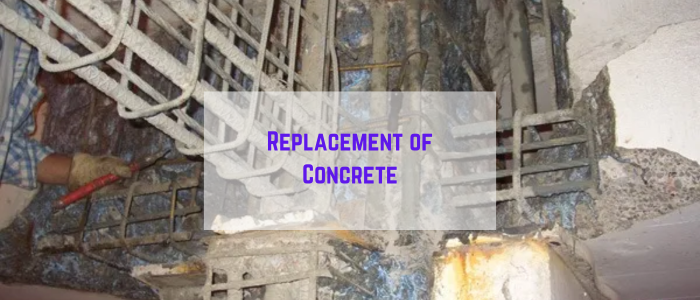Concrete Repair
Before getting into concrete repair, you should assess thoroughly the condition of concrete by visual inspection supplemented with other tests if necessary.
A visual inspection of the structure, an assessment of corrosion activity, destructive and nondestructive testing, a review of laboratory results from chemical and petrographic analysis of concrete samples, a review of available test data, a review of records of any prior repair work, a review of maintenance records, and a review of available design and construction documents are some of the possible components of the evaluation.
After, investigation reveals the causes of damage, you should select the appropriate repair technique (materials + methods).
Replacement of Concrete
Replacement of damaged concrete elements involves requires destruction, removal, and replacement of the existing structural components with new ones. After appropriate jacking is used to release applied loads on the damaged structural part, the demolition procedure is executed.
Great care should be included to avoid damaging existing steel bars if present. This measure is considered to splice the existing bars with the newer ones.
When a structural member suffers significant damage, a full replacement is taken into consideration as the most economical option for restoring the member.
The replacement technique has been extensively employed to restore earthquake-damaged structures. The strength of the new built structural member needs to be either somewhat better than that of the preceding element or comparable.
All damaged concrete structural members such as beam, columns, braces and walls can be replaced.
This repair method can be used if none of the other strengthening techniques is adequate.
This method is applied not just to restore decaying buildings but also to lengthen the lifespan of other structures, particularly bridges.
The suggestions and specifications of the relevant codes should be followed when specifying repair materials.
Steps for Replacement of Concrete
- If the damaged structural member is load-bearing, shoring needs to be provided adjacent to it to withstand loads while the member is demolished and not present to carry the loads.
- The structural member needs to be carefully demolished with the right instruments, like saws and chipping tools.
- If steel bars are already there, they should not be broken in order to join them with newly installed steel reinforcements for the new structural member.
- To ensure that there is a sufficient bond between the new and existing materials, the surface of the surrounding structure should be prepared, such as by roughening the surface.
- New reinforcing bars should be spliced to existing bars.
- If it is necessary to add new reinforcing bars to the current structure, these bars should be fastened by inserting them into epoxy-filled holes.
- The depth of the holes needs to be adequate in order to make sure that the full potential of the steel bars is utilized. It is advised to consulate epoxy manufacturer for the proper depth of the bar and for the instructions for installing the epoxy.
- The freshly mixed concrete may be poured using the right tools. For instance, applying shotcrete or utilizing the formworks.
- If formworks are employed, fresh concrete is poured through an access hole near the top of the formwork, and extra holes may be required to provide access for vibrators to consolidate concrete.
- Lastly, a suitable curing is employed to guarantee that the concrete reaches the necessary strength.
Read Also:
Methods of Crack Repair in Concrete (1)
Methods of Crack Repair in Concrete (2)
